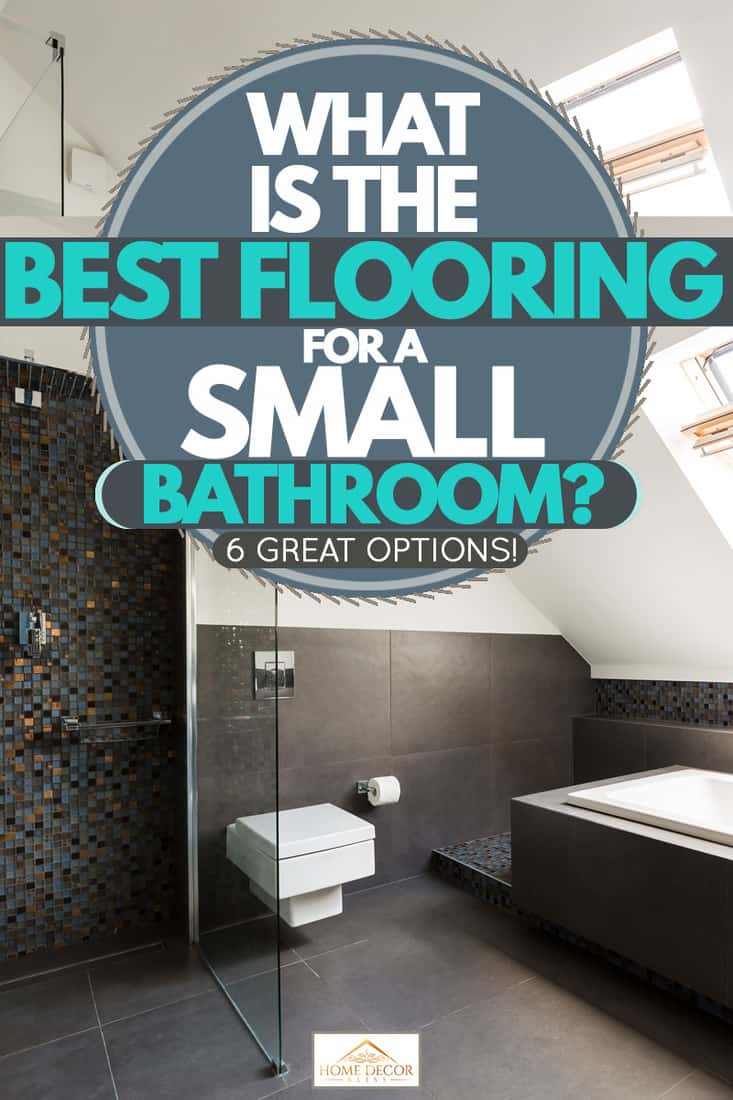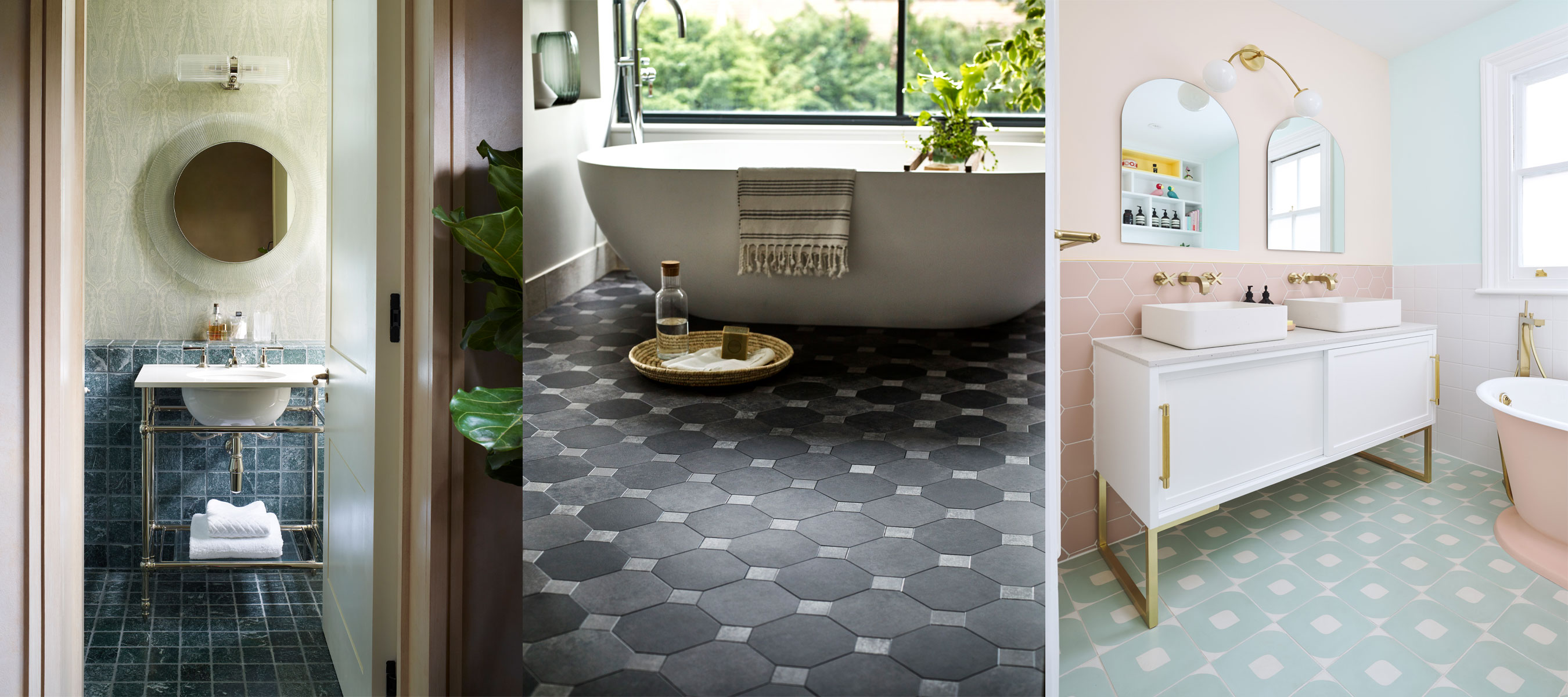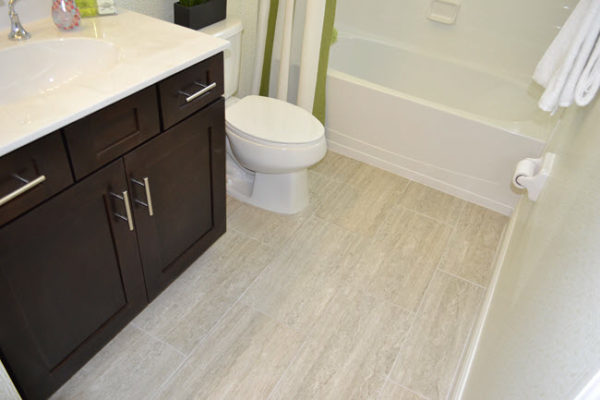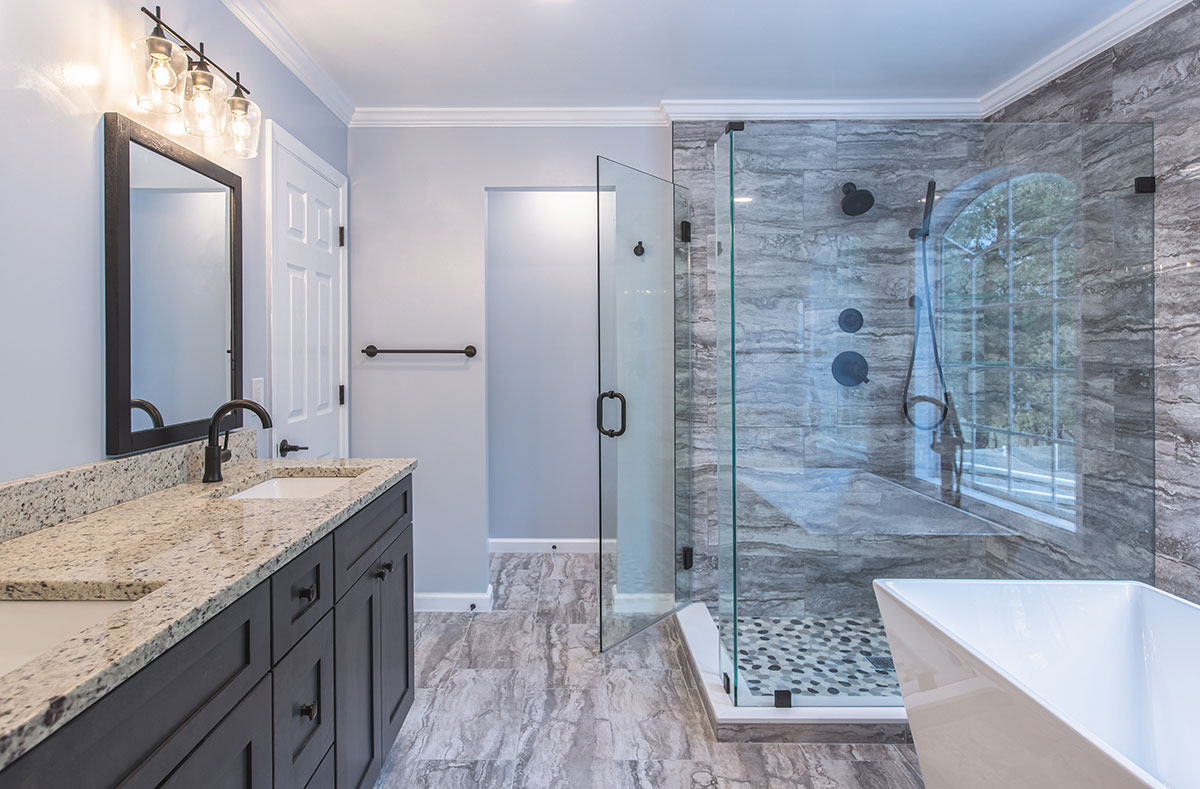Tile Flooring: Durability and Design Flexibility
When I decided to renovate my small bathroom, I knew that choosing the right flooring was crucial. Tile flooring immediately stood out to me for its durability and design flexibility. Here’s what I discovered about tile flooring and why it became my top choice for my small bathroom.
- Durability: One of the main reasons I chose tile flooring was its durability. Bathrooms are high-moisture areas, and tile is known for its water resistance. It doesn’t warp or swell like some other materials, making it a long-lasting option. I felt confident that the tile would stand up to the daily wear and tear of my bathroom.
- Variety of Designs: The design options with tile are virtually limitless. I was able to choose from a wide range of colors, patterns, and textures to match my aesthetic preferences. Whether I wanted a sleek, modern look or a more traditional style, there was a tile option that fit perfectly. I ended up choosing a beautiful mosaic pattern that added a touch of elegance to my small space.
- Ease of Maintenance: Keeping my bathroom clean is important to me, and tile flooring makes maintenance easy. It’s resistant to stains and easy to wipe down. Regular sweeping and mopping with a mild cleaner kept the tiles looking pristine. For stubborn grout stains, a mixture of baking soda and water worked wonders.
- Cost-Effective Options: While some tiles can be expensive, I found many affordable options that fit my budget. Ceramic tiles, in particular, offer great value for the price. They provided the durability and design flexibility I wanted without breaking the bank. Plus, I found that installing tiles in a small bathroom required fewer materials, which further reduced costs.
- Cool and Comfortable: Tile flooring stays cool underfoot, which can be refreshing, especially in a bathroom. To add warmth and comfort, I placed a soft, absorbent bath mat near the shower and sink. This small addition made the space more inviting while maintaining the practical benefits of tile.
- Added Resale Value: Investing in high-quality tile flooring can increase the resale value of a home. Prospective buyers often appreciate the durability and aesthetic appeal of tile. Knowing this made me feel even better about my decision, as it was not only enhancing my daily living experience but also potentially boosting my home’s market value.

Vinyl Flooring: Affordable and Water-Resistant Options
During my bathroom renovation, I considered various flooring options, and vinyl flooring quickly became a top contender. Its affordability and water resistance made it an attractive choice for my small bathroom. Here’s what I learned about vinyl flooring and why it worked so well for me.
Cost-Effective Solution One of the biggest advantages of vinyl flooring is its affordability. Compared to other flooring materials, vinyl is much less expensive, making it a great option for budget-conscious renovations. I found high-quality vinyl planks that mimicked the look of real wood and stone, providing a stylish finish without the hefty price tag.
Water Resistance Bathrooms are prone to moisture, and vinyl flooring is highly water-resistant. This feature was crucial for me, as it ensured that my floors would withstand spills, splashes, and humidity without getting damaged. Unlike some other materials, vinyl doesn’t warp or swell when exposed to water, making it ideal for bathroom use.
Easy Installation Installing vinyl flooring was a breeze, even for a DIY novice like me. Many vinyl planks come with a peel-and-stick backing or a click-lock system, which makes the process quick and straightforward. I was able to complete the installation over a weekend, saving on professional installation costs.
Comfort Underfoot Vinyl flooring is softer and warmer underfoot compared to tile or stone. This added comfort was a pleasant surprise, especially in a bathroom where I often walk barefoot. The slight cushioning of vinyl made the bathroom feel more inviting and comfortable.
Low Maintenance Keeping vinyl flooring clean is simple and hassle-free. Regular sweeping and occasional mopping with a mild cleaner kept the floors looking fresh and new. Its stain-resistant properties meant that any spills were easy to wipe up without leaving a mark.
Stylish Options The variety of styles and patterns available in vinyl flooring is impressive. I was able to choose from options that mimicked natural wood, stone, and ceramic tiles. This allowed me to achieve the look I wanted while benefiting from the practical advantages of vinyl. The result was a beautiful bathroom floor that perfectly complemented my overall design.
Laminate Flooring: Style and Practicality for Small Spaces
When renovating my small bathroom, I wanted a flooring option that combined style and practicality. Laminate flooring emerged as a strong candidate. It offers a range of benefits that make it suitable for small bathrooms. Here’s what I discovered about laminate flooring.
Aesthetic Appeal Laminate flooring can convincingly mimic the look of hardwood, stone, or tile, providing a high-end appearance at a lower cost. The realistic textures and patterns available allowed me to find a design that matched my vision for the bathroom. I chose a laminate that resembled light oak, giving the space a warm and inviting feel.
Durability Laminate flooring is known for its durability. It’s resistant to scratches, dents, and stains, making it ideal for high-traffic areas like bathrooms. This durability ensured that my bathroom floors would remain in great condition despite daily use.
Water Resistance While traditional laminates can be susceptible to water damage, many modern laminates are designed to be water-resistant. These products feature sealed edges and water-repellent surfaces that make them suitable for bathrooms. I made sure to choose a water-resistant laminate to protect against potential moisture issues.
Ease of Installation Installing laminate flooring was a straightforward process. The click-lock system allowed me to lay the planks over the existing subfloor without the need for glue or nails. This floating floor installation saved time and effort, and I was able to complete the project on my own.
Maintenance Simplicity Keeping laminate flooring clean is easy. Regular sweeping and occasional damp mopping kept the floors looking their best. The protective top layer of laminate also made it resistant to spills and stains, which was perfect for a bathroom setting.
Budget-Friendly Laminate flooring offered a cost-effective solution for my bathroom renovation. It provided the look of more expensive materials like hardwood and stone without the high price. This affordability allowed me to achieve a stylish bathroom makeover while staying within my budget.
Natural Stone Flooring: Luxury and Longevity
When considering flooring options for my small bathroom, natural stone flooring stood out for its luxurious appeal and longevity. Though it’s a bit more of an investment, the timeless beauty and durability of natural stone made it a compelling choice. Here’s why I decided to go with natural stone flooring.
Timeless Elegance Natural stone flooring exudes a sense of timeless elegance that’s hard to match. Each stone tile has unique variations in color and pattern, creating a one-of-a-kind look for my bathroom. The natural beauty of the stone added a touch of sophistication to the space.
Exceptional Durability One of the standout features of natural stone is its durability. Stones like marble, granite, and slate are incredibly hard-wearing and can last for decades with proper care. This durability made natural stone a worthwhile investment for my bathroom, promising long-term performance and minimal wear and tear.
Water Resistance Natural stone is naturally water-resistant, making it suitable for bathroom environments. However, it’s important to seal the stone to enhance its resistance to water and stains. I made sure to apply a high-quality sealant, which added an extra layer of protection and made maintenance easier.
Cool Underfoot Stone flooring stays cool underfoot, which can be particularly refreshing in a bathroom. To counterbalance the coolness, I added plush bath rugs in key areas like in front of the sink and shower. This combination provided comfort and warmth without sacrificing the luxurious feel of the stone.
Versatility in Design The variety of natural stone options allowed me to find the perfect match for my bathroom design. Whether I wanted the classic look of marble, the rustic charm of slate, or the bold elegance of granite, there was a stone that fit my style. I chose a beautiful marble tile with subtle veining that added a touch of luxury to my bathroom.
Added Home Value Installing natural stone flooring can increase the value of a home. Prospective buyers often appreciate the luxury and durability that natural stone offers. Knowing that my choice could boost my home’s market value made me feel even better about my investment.
Cork Flooring: Eco-Friendly and Comfortable Choices
While exploring flooring options for my small bathroom, cork flooring caught my attention due to its eco-friendly properties and comfort. Cork is a renewable resource that offers several practical benefits. Here’s why I considered cork flooring for my bathroom renovation.
Sustainability Cork flooring is made from the bark of the cork oak tree, which regenerates after harvesting. This makes it a highly sustainable and eco-friendly choice. By choosing cork, I felt good about reducing my environmental footprint while enhancing my home.
Comfort Underfoot One of the most appealing features of cork flooring is its comfort. Cork has a natural cushioning effect, making it soft and comfortable to walk on. This was especially important for my bathroom, where I often walk barefoot. The slight give of cork flooring added a cozy and inviting feel to the space.
Thermal Insulation Cork flooring provides excellent thermal insulation. It stays warm underfoot, which is a great advantage in a bathroom setting. This insulating property made my bathroom more comfortable year-round, reducing the chill of cold floors during the winter months.
Water Resistance Cork is naturally water-resistant, which is a key consideration for bathroom flooring. However, it’s important to seal cork flooring properly to enhance its moisture resistance. I applied a protective sealant that helped prevent water damage and made cleaning easier.
Sound Insulation Cork flooring has sound-absorbing properties, which helped reduce noise in my bathroom. This made the space more peaceful and reduced the echo that can sometimes occur in tiled bathrooms. The sound insulation added an extra layer of comfort to my bathroom experience.
Aesthetic Appeal Cork flooring comes in a variety of colors and patterns, allowing me to choose a design that complemented my bathroom decor. I opted for a light, natural cork that brightened up the small space and created a warm, earthy ambiance. The unique texture and appearance of cork added character to my bathroom.
Tips for Choosing the Right Flooring for Your Small Bathroom
Selecting the right flooring for a small bathroom can be a daunting task with so many options available. Through my renovation journey, I learned several valuable tips that helped me make the best choice for my space. Here are my top tips for choosing the right flooring for a small bathroom.
Consider Moisture Resistance Bathrooms are high-moisture areas, so it’s crucial to choose flooring that can withstand water exposure. Options like tile, vinyl, and sealed natural stone are excellent choices for their water resistance. Avoid materials that can warp or swell when exposed to moisture.
Think About Durability Bathroom floors need to endure daily use and frequent cleaning. Durable materials like tile, stone, and high-quality vinyl can stand up to wear and tear. Consider how much foot traffic your bathroom gets and choose a flooring option that can handle it.
Balance Style and Functionality While aesthetics are important, functionality should not be overlooked. Choose flooring that complements your bathroom’s design but also meets practical needs. For example, a beautiful but slippery floor might not be the best choice for a bathroom used by children or elderly individuals.
Consider Installation and Maintenance Some flooring options are easier to install and maintain than others. If you’re planning a DIY project, consider materials like vinyl or laminate that are relatively easy to install. Also, think about the maintenance required to keep the flooring looking its best and choose accordingly.
Budget Wisely Set a budget for your bathroom flooring and stick to it. There are quality options available at various price points, from affordable vinyl and laminate to higher-end natural stone. Shop around and compare prices to find the best deals without compromising on quality.
Don’t Forget Comfort Consider the comfort underfoot, especially if you spend a lot of time standing in the bathroom. Flooring options like cork and vinyl provide a softer feel compared to harder materials like tile and stone. Adding rugs or mats can also enhance comfort.
Look for Slip Resistance Safety is paramount in a bathroom. Choose flooring with a slip-resistant surface to prevent accidents, especially in wet areas. Many tiles and vinyl flooring options come with textured surfaces designed to reduce slipping.
What is the Best Flooring for Bathrooms?
What is the Best Flooring for Bathrooms?
Related Posts:






